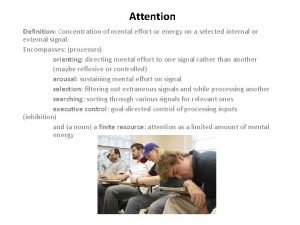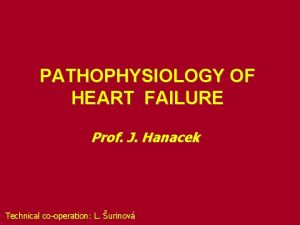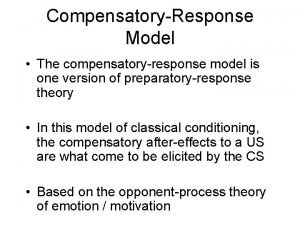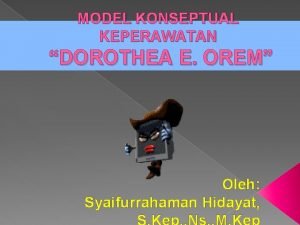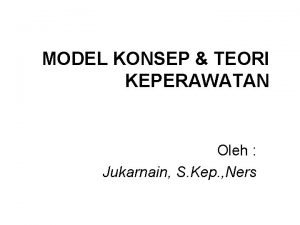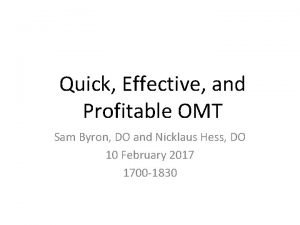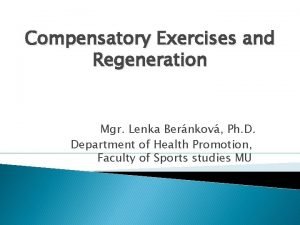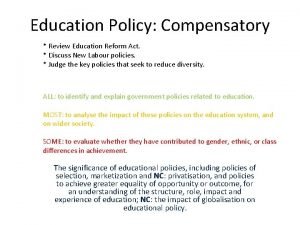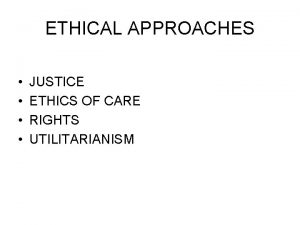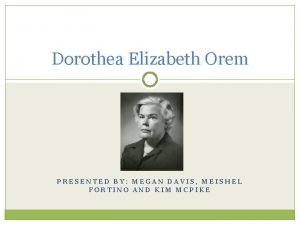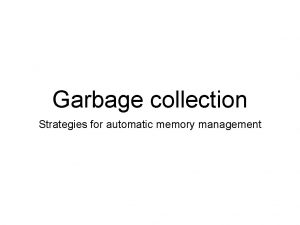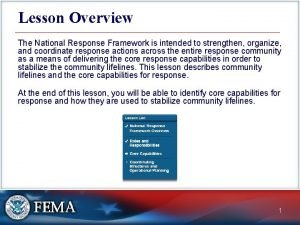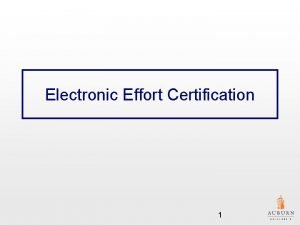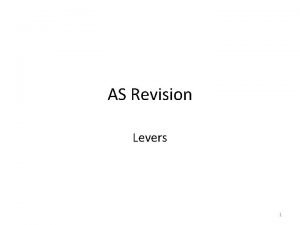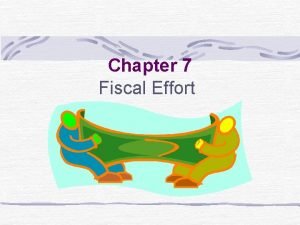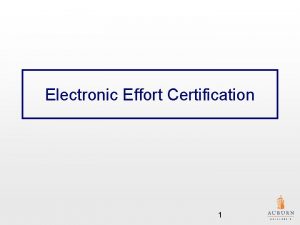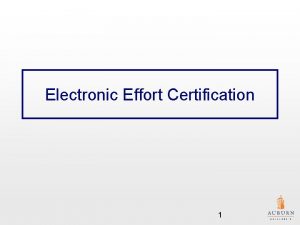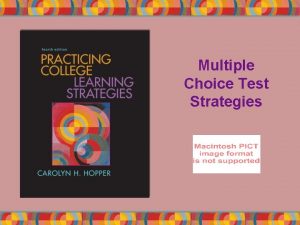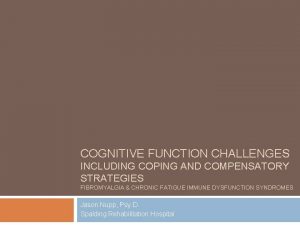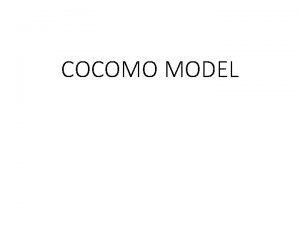Choice Collection of Choice Strategies Mental Effort Compensatory





























- Slides: 29

Choice

Collection of Choice Strategies Mental Effort Compensatory vs. Non -Compensatory Alternative vs. Attribute Exhaustive Linear Additive Very High Compensatory Alternative Yes Additive Difference Very High Compensatory Attribute Yes Dominance Medium Non-Compensatory Alternative Yes Conjunctive Low Non-Compensatory Alternative No Disjunctive Low Non-Compensatory Alternative No Lexicographic Medium Non-Compensatory Attribute No Elimination-by. Aspects Medium Non-Compensatory Attribute No Low Non-Compensatory Alternative No Recognition Heuristic

Compensatory vs. Non-Compensatory • Compensatory strategies trade off low values on one dimension against high values on another - e. g. when choosing a car, a buyer trades off poor gas mileage for a car that looks good • In non-compensatory strategies, alternatives are eliminated if they fall outside predefined boundaries. - e. g. reject app if GRE <1, 000 and GPA < 3. 0

By Alternative vs. By Attribute • If processing is by alternative, processing of one alternative is completed before the processing of another alternative is begun. • If processing is by attribute, processing of one attribute is completed before the processing of another attribute is begun.

Exhaustive • All attributes and all alternatives are fully processed before a judgment or decision is made.

Collection of Choice Strategies Mental Effort Compensatory vs. Non -Compensatory Alternative vs. Attribute Exhaustive Linear Additive Very High Compensatory Alternative Yes Additive Difference Very High Compensatory Attribute Yes Dominance Medium Non-Compensatory Alternative Yes Conjunctive Low Non-Compensatory Alternative No Disjunctive Low Non-Compensatory Alternative No Lexicographic Medium Non-Compensatory Attribute No Elimination-by. Aspects Medium Non-Compensatory Attribute No Low Non-Compensatory Alternative No Recognition Heuristic

Strengths and Limitations • If you have lots of time and energy, the linear additive strategy and the additive difference strategy will perform best. • Many times, simpler strategies perform almost as well and take less time and effort.

Strengths and Limitations • Evidence suggests that people shift from simpler to more complex strategies if they become more motivated. • Some evidence suggests that people shift from more complex to simpler strategies when they must make decisions under time pressure.

Compensatory

Linear Additive Weight all the attributes by their importance (with reference to the current goals of the decision maker). Then consider each alternative one at a time and calculate a global utility by valuing each attribute, weighting it by its importance and adding up the weighted values. The is a rigorous version of Benjamin Franklin’s advice to a decision maker, and it is the strategy prescribed by economic theories for rational choice. It tends to find the uniquely “best all around” alternative in the choice set, but it requires a great deal of effort and time for complex choice sets.

Additive Difference Consider two alternatives at a time; compare attributeby-attribute, estimating the difference between the two alternatives, and sum up the differences across the attributes to provide a single overall difference score across all attributes for that pair. Carry the winner of this comparison over to the next viable alternative and make the same comparison. At the end of this process, the best alternative is the one that has “won” all the pairwise comparisons. This strategy is commonly used in the final stages of everyday choices, e. g. , among consumer goods. It is sometimes called a “voting rule. ”

Non-Compensatory

Dominance Search for an alternative that is at least as good as every other alternative on all important attributes and choose it, or find an alternative that is worse than any other alternative on all attributes and throw that “worse” alternative out of the choice set. Consistent with prescriptions for rational choice, but will only “work” to select a unique best alternative if there is a “super-alternative” that beats all other in the choice set; dominance is often used as a first-stage strategy to weed out the weakest “dominated alternatives” in a large choice set.

Conjunctive (Satisficing) First, set “acceptability” cutoff points on all important attributes, then look for the first alternative that is at least as good as the cutoff values on all important attributes or use the strategy to select a set of goodenough alternatives (all above the cutoff points) for further consideration. Satisficing tends to select a homogeneous subset of “good” alternatives. It is often used as a first-stage strategy to screen out “losers” or in a general satisficing strategy to find the first alternative that is “good enough”—very common in consumer choice.

Disjunctive First, set “acceptability” cutoff points on the important attributes, then look for the first alternative that is at least as good as the cutoff value on any attribute, or use the strategy to select a set of alternatives that are each very good on at least one dimension for further consideration. This strategy tends to select a heterogeneous subset of “specialists. ”

Lexicographic First, review the attributes and pick the one most important attribute, then choose the best alternative on that attribute. If there are several “winners” on the first attribute, go on to the next-most important attribute and pick the best remaining attribute(s) on that attribute (repeating until only one alternative is left)— common in everyday choices. There is an opportunity for “manipulation” in that the order in which attributes are considered has a big effect on the final choice. This strategy is very close to Gerd Gigerenzer’s highly successful “take the best” fast and frugal heuristic.

Elimination-by-Aspects Pick the first attribute that is salient and set a cutoff “acceptability” point on that attribute. Throw out all alternatives that are below the cutoff on that on attribute, then pick the next most attention-getting attribute, sent an acceptability cutoff on that attribute and throw out all alternatives that are below the cutoff again (repeating until only one alternative is left)—often used to screen out “losers. ” The user of attributes considered (aspects) is heavily dependent on momentary salience, and there are some possibilities for manipulation as in the lexicographic strategy.

Recognition Heuristic In some choices, people are so poorly informed about the alternatives that they simply rely on name recognition, that is, they choose the first alternative they recognize. Dan Goldstein and Gigerenzer (2002) have shown that in many realistic choices and judgments (choosing the city with a larger population, choosing the stock that is likeliest to increase in price, etc. ), the fast-and-frugal recognition choice heuristic behaves surprisingly well.

Multi-Attribute Choice aka Multi-Criteria Analysis aka Multi-Criteria Decision-Making


Weighted Sum Model (WSM) 1. Determine what you will be comparing 2. Determine evaluation criteria 3. Weight criteria 4. List alternative choices and rate them 5. Standardize values (e. g. , z-scores) 6. Do the math and rank them

Applications • Colleges • Cars and other products • Jobs • Competitors • Applicants (students, employees) • Political candidates • Vacations • Houses

1. Comparing Colleges

2. Evaluation Criteria Cost ($) US News Ranking Vibe (0 -10)

3. Weight Criteria Cost ($) 60% US News 20% Ranking Vibe (0 -10) 20%

4. List Choices and Rate Them Cost ($) 60% US News 20% Ranking Vibe (0 -10) 20% Vanderbilt Stanford Purdue 49, 816 51, 354 28, 804 14 7 56 8 7 4

5. Standardize Values Vanderbilt Stanford Purdue 60% 4. 9 5. 1 2. 9 US News 20% Ranking 1. 4 0. 7 5. 6 2 3 6 Cost ($) Vibe (0 -10) 20%

6. Do the Math and Rank the Choices Vanderbilt Stanford Purdue 60% 4. 9 5. 1 2. 9 US News 20% Ranking 1. 4 0. 7 5. 6 2 3 6 3. 68 3. 80 4. 06 Cost ($) Vibe (0 -10) 20%

 Mental effort definition
Mental effort definition Liceo onesti fermo
Liceo onesti fermo Compensatory mechanism of heart failure
Compensatory mechanism of heart failure Compensatory skills
Compensatory skills Normative vs descriptive ethics
Normative vs descriptive ethics Mpkp jiwa
Mpkp jiwa What is compensatory response
What is compensatory response Compensating and balancing extractions
Compensating and balancing extractions Dorothea orem
Dorothea orem Protrusive balanced occlusion
Protrusive balanced occlusion Peo occupational therapy
Peo occupational therapy Tujuan teori keperawatan
Tujuan teori keperawatan Pvkov
Pvkov Orem
Orem Sam byron
Sam byron Compensatory exercises
Compensatory exercises Compensatory education policies
Compensatory education policies Theories of distributive justice
Theories of distributive justice Dorothea elisabeth orem
Dorothea elisabeth orem Landsat collection 1 vs collection 2
Landsat collection 1 vs collection 2 Documentary collection definition
Documentary collection definition Garbage collection strategies
Garbage collection strategies Chapter 20 mental health and mental illness
Chapter 20 mental health and mental illness Mental health jeopardy questions
Mental health jeopardy questions Math multiple choice test taking strategies
Math multiple choice test taking strategies Good choice or bad choice
Good choice or bad choice Stabilizing community lifelines is a primary effort during
Stabilizing community lifelines is a primary effort during Tractive effort
Tractive effort Effort certification
Effort certification What is a third class lever
What is a third class lever
